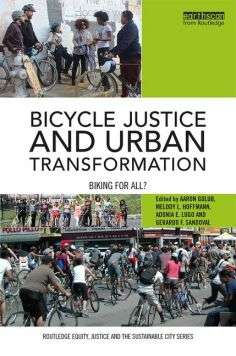Researchers find that bike paths and policies favor recreational and upper-income cyclists

As California and its myriad communities develop paths and policies to promote cycling, one segment of the bike-riding population remains largely invisible to policymakers: Those for whom bicycles are an economic necessity, not an option to driving a car.
Two University of California, Riverside researchers contend in "Bicycle Justice and Urban Transformation: Biking for all?" (Routledge, July 2016) that attempts to regulate cycling "are extensions of a general movement in society to regulate space by law and to marginalize the poor, students, and racial minorities from the urban landscape."
"Bicycle Justice and Urban Transformation" is an edited collection of case studies from researchers and activists who examine the growth of bicycle commuting around the world, a trend in the United States which assumes that cyclists are white and middle-class. The reality, however, is that the American cycling public is quite diverse, as the book demonstrates in case studies of the impacts of cycling policies on low-income commuters.
In a chapter titled "Rascuache cycling justice," UC Riverside scholars Alfredo Mirandé, professor of ethnic studies and sociology, and Raymond L. Williams, distinguished professor of Spanish, draw from Mexican literature and culture to explain the disparate experiences of cyclists from the lowest to upper-middle-class socioeconomic strata in Southern California.
Mirandé and Williams identify cycling commuters on the lowest rungs of the socioeconomic ladder as rascuache, "the typically unhelmeted and uniformless cyclists who most urgently rely on the bicycle for transportation." Those on the upper rungs they refer to as Catrín, those "respectable, professional and elite cyclists who use bicycles for sport or recreation."
Rascuache is a Mexican colloquialism that originally connoted inferiority, but in recent decades has come to mean an underdog who is resourceful and adaptable, they explain. The image of the Catrín cyclist is drawn from a famous painting by Mexican artist Jose Guadalupe Posada of La Catrina, a female skeleton dressed only in a hat characteristic of the European upper class of the early 20th century.
"Rascuache cyclists generally turn to cycling out of economic necessity and use cycling as a way to commute from one place to another because they cannot afford an automobile or otherwise lack access to public transportation," they write. "Catrín cyclists, on the other hand, use cycling for recreation and/or sport. For Catrín cyclists, the bicycle is not always an alternative mode of transportation. … In public domain streets, Catrín riders increase their safety through their numbers, sometimes taking over entire lanes of streets by riding en masse, and in doing so, reaffirm their right to public space in ways that rascuache cyclists cannot."
References to rascuache cyclists abound in Mexican literature, with bicycles expressed as personalized extensions of the human body, memory, and access to work or education and freedom, the researchers say.
"Consequently, when owners lose their bicycles to theft, especially rascuache cyclists, they sometimes perceive it not simply as the economic loss of a neutral object but as the loss of a physical self. For the student commuter or working-class cycling commuter, for example, the loss of a bicycle can mean that, the next day, one cannot attend class or get to work."
Policymakers and urban planners in much of Southern California – where a car culture dominates – are not highly receptive to rascuache cyclists, the researchers said, noting the lack of secured bicycle-parking areas at shopping centers, commuter rail stations and college campuses; bike paths that are designed with recreational users – not low-income commuters – in mind; and bike-safety legislation that negatively impacts cyclists who can least afford helmets and reflective clothing.
"We argue that the proposed mandatory helmet law was directed specifically at rascuache cyclists, as this is the only group that typically does not wear helmets, primarily for economic reasons," Mirandé and Williams write. "A high-quality helmet might cost as much, or more, than their inexpensive bikes. Moreover, by creating this law, the California Legislature set up a scenario to further criminalize, harass, and control economically disadvantaged cyclists."
However, some communities are beginning to give cyclists priority over cars on many streets, such as Long Beach and Claremont in California, as well as in Minneapolis and Portland, Oregon. And experiments with street closures and permanent bike paths in Bogotá and Medellín, Colombia, are serving as models for some U.S. cities considering more sustainable transportation practices.
Los Angeles, for example, began experimenting in 2010 with Ciclovía, the Colombian practice of closing certain streets to cars on Sundays. Last year, officials in California's largest city announced plans to make the entire city more bicycle friendly.
"Using European and Latin American models, Los Angeles is slowing down car traffic and providing more space on the streets for cyclists," the researchers note.
Even so, "… social class and socioeconomic disparities remain significant impediments to the implementation of a just and sustainable cycling policy on both sides of the border," Mirandé and Williams conclude. "Cycling policy in the United States clearly favors Catrín, middle- and upper-class recreational cyclists, over the rascuache riders who use bicycles not for speed, sport or recreation, but out of economic necessity."
More information: Bicycle Justice and Urban Transformation. www.routledge.com/Bicycle-Just … p/book/9781138950245
Provided by University of California - Riverside


















